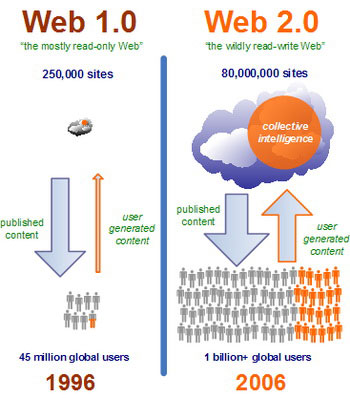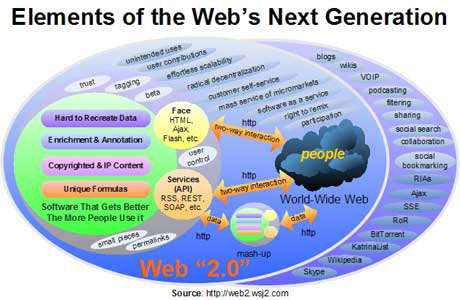5 valuable web 2.0 development experience
Based on interviews, a series of web 2.0 analysts and executives believe that quick, regular, and intimate contact with users will be the key to success. Emerging software development businesses .
It was time to slow down, the trend of dividing the project into many separate development stages of traditional businesses was replaced by speed, the ability to react quickly to the 'disorganized' level of startups web 2.0
For example, look at Flickr. The latest update of the digital photo sharing service last week was the 36th update, with 627 changes made by 21 developers.

Web 2.0 is flourishing and helps many businesses to flourish, but it also contains many risks to be closed soon because of the poor results.
1. Break down barriers between developers and end users, support users, better product warranty
Wesabe Inc., the enterprise that manages a personal finance website does not have a formal, well-maintained maintenance team, instead relying on user, founder and CEO Marc Hedlund.
Websabe developers collaborate directly with users to design new features, then Hedlund will verify. If Hedlund doesn't detect a problem, those features will be quickly added to Wesabe.com
Hedlund said that before launching Wesabe two years ago, he had researched a lot of popular development techniques that web 2.0 companies use. Finally he came to the conclusion: applications will be better designed when developers have close links with users who directly use the product.
The reaction of the user directly using the product, regardless of whether the complaint or acknowledgment will become meaningful motivation for the developer, rather than the statistical map of the user's wishes, It is often boring presentation in meetings.
William Gribbons, director of a human resources training program at College, Waltham, Massachusetts, said big companies would gain a lot of financial benefits using web 2.0 technology to develop applications. for staff.
Gribbons urges application development teams in businesses to focus on reaching more users to gather their needs and create a systematic and controlled way of monitoring user reactions. with product release models.
2. Select a simple development direction for the product to be easy to deploy and expand later
Quite a number of web 2.0 applications for users look simple but the face-to-face reality and simplified features are the result of the hard work of developers, working closely together. with users.
Stan Schroeder, blogger of Mashable, a social network that tracks web 2.0 companies, commented on a recent article that developers have begun to realize the fact that the simpler the service is, the more potential it is. Large, easy to upgrade now, adding new applications and programs to provide complex services: ' I find the service cumbersome features can be difficult to implement. The problem is how much more powerful the application is, the higher the specificity, the more complicated it is. Therefore, once the application is equipped with more advanced new features, the number of users it targets will shrink . '
Often, traditional IT businesses still plan on a certain type of user needs, then develop a range of solutions that can meet and solve that need, hoping users will be happy. Please with one of them. However, according to William Gribbons, when there is no regular interaction with users, web developers will not realize the need to use their simple interface services.
3. Choose the appropriate development language
Currently, web 2.0 companies often use dynamic programming languages such as Ruby, Python, Perl and PHP, better choices than Java from Sun Microsystems Inc. or Microsoft .Net.
Jeffrey Hammond, an analyst from Forrester Research Inc Cambridge, Massachusetts, said that once developers master one of some dynamic languages, they can design new applications faster than 30. -40% compared to Java or .Net.
According to a survey by Evans Data Corp (a research company in Santa Cruz, California), released in December 2008, more than half of North American application developers currently have a high level of skill. While more than half of them often use scripts that are less than 20% of the time of product design, according to Evans' survey, the number of developers using programming and time languages. Investment time will also increase.
4. Release early and often
Just like Flickr, Wesabe - San Francisco-based company - regularly updates its website several times a day. The constant close interaction with users helps Wesabe developers quickly get feedback on the errors that arise. In addition, Wesabe and many other web 2.0 businesses often maintain independent test versions, helping them track user reactions to certain updated features.
For example, Reading Inc's Mixx.com news social network, which allows users to post and rate important news, is often updated more regularly than traditional IT applications usually one or two. times per week.
' In fact, for Mixx a' long-term 'plan that will only last for six months, ' McGill, the founder of McLean in 2007 after working hard as a general manager of Yahoo News. and vice president of strategy for USA Today, said.
Mixx.com's development team met each day to discuss the day's work, using the Scrum interactive exchange method.
5. Let users, not app developers, decide the new feature of the product
Leading businesses doing business on the Internet such as Amazon or Google often release new features for a small group of test users and then compare their feedback to other groups. The big men all confirmed that this method would provide more accurate and valuable remarks for new features or products compared to customer surveys or discussions between users and managers. Products.
Mixx.com hopes to one day follow this method. McGill said, while insisting more companies are ready to change to make use of the user community.
Businesses "replace blood"
Observers acknowledge that while the majority of large firms are still not really excited to soon make use of web 2.0 development techniques, some applications still have not really met the demand, but began to there are signs of molting when businesses realize the value of new technology, new forms of deployment and development.
This is a survey conducted by Computerworld in July last year with more than 1,300 developers of TopCoder Inc in Glastonbury, Connecticut. 70% of surveyed members answered that development teams in traditional businesses can get a lot of benefits from web 2.0 technology, especially the introduction of new features, quickly gathering feedback of users and even with good quality warranty programs.
In addition, 57% of respondents surveyed: analytical skills and problem solving will be key requirements for new generation application developers, while 18% said that the requirement It is important to work with online communities, 24% affirming that the skill with a long-term determinant is code development.
You should read it
- 5 work on Computer Science you can do at home
- Microsoft offers a free introductory web development course
- Download Java Development Kit 8-update-281
- Game developers have new tools to evaluate the player experience
- The precious travel experience for those who first arrive in Oakland, California
- How to dig diamonds and ores in Minecraft
- How to keep your jewelry shiny and new?
- The precious thing the Chinese father learned after his 2-year-old daughter's trip
May be interested
- Optimize Windows 7 performance
 it is expected that in october, windows 7 will officially launch users with many promising features. however, now users can download the trial
it is expected that in october, windows 7 will officially launch users with many promising features. however, now users can download the trial - Avoid irony situations on Facebook
 ignoring facebook's privacy options can cause users to experience funny and bad situations.
ignoring facebook's privacy options can cause users to experience funny and bad situations. - Browse the web faster and easier with Firefox 3.5
 the newly released version of firefox 3.5 has had some success. the new version has a significantly faster web browsing process, more flexible tab control ...
the newly released version of firefox 3.5 has had some success. the new version has a significantly faster web browsing process, more flexible tab control ... - How much does Windows 7 sell for?
 currently many users still do not really know how much windows 7 will be sold even if the price policy applied to this operating system has been announced.
currently many users still do not really know how much windows 7 will be sold even if the price policy applied to this operating system has been announced. - Web 2.0 - Find the 'seven parts' of the iceberg
 seeing the 'evolution' of the web world, people realized that it was over when web users only 'read and watch', passive with sources.
seeing the 'evolution' of the web world, people realized that it was over when web users only 'read and watch', passive with sources. - Troubleshoot computer problems that do not start
 why don't we try to find out if there is any way we can fix the problem without losing all the data in the installation drive?
why don't we try to find out if there is any way we can fix the problem without losing all the data in the installation drive?






 How did Apple sweep and occupy the No. 1 ranking of the world's 15 most valuable brands?
How did Apple sweep and occupy the No. 1 ranking of the world's 15 most valuable brands? The wizard chooses the development platform for the application - Application Development Platform
The wizard chooses the development platform for the application - Application Development Platform Top 5 free game development software tools
Top 5 free game development software tools 5 work on Computer Science you can do at home
5 work on Computer Science you can do at home Microsoft offers a free introductory web development course
Microsoft offers a free introductory web development course